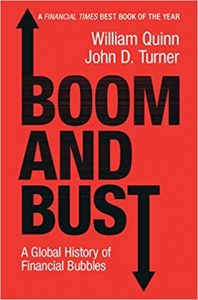In Boom and Bust: A Global History of Financial Bubbles, William Quinn and John D. Turner take readers on a 300-year tour through the history of the world’s most significant financial bubbles, aiming to improve understanding of why bubbles happen, their destructive and sometimes beneficial consequences and potential policy measures to help prevent bubbles. Hans G. Despain praises the book as a well-written, entertaining and accessible read that is particularly impressive in providing a predicative analytical framework for theorists, policymakers and investors.
Boom and Bust: A Global History of Financial Bubbles. William Quinn and John D. Turner. Cambridge University Press. 2020.
Find this book (affiliate link): ![]()
 We are just 21 years into the 21st century and there have already been three major economic crises, each one worse than the one before. The century began with a severe global slowdown in the world’s largest economies of the United States, the European Union and Japan. The slowdown was topped off with the dot-com collapse in financial markets caused by excessive speculation in internet companies. The Financial Crisis of 2008 was even more devastating, destroying incomes, crushing middle-class lives and increasing the number of low-income workers. We are now enduring the third major crisis, accelerated by the economic shutdown caused by the COVID-19 pandemic. Liberal state governments, especially the US and the UK, have addressed the economic hardships ineptly at best. Unemployment remains high, incomes destroyed and an unprecedented number of small businesses have gone bankrupt.
We are just 21 years into the 21st century and there have already been three major economic crises, each one worse than the one before. The century began with a severe global slowdown in the world’s largest economies of the United States, the European Union and Japan. The slowdown was topped off with the dot-com collapse in financial markets caused by excessive speculation in internet companies. The Financial Crisis of 2008 was even more devastating, destroying incomes, crushing middle-class lives and increasing the number of low-income workers. We are now enduring the third major crisis, accelerated by the economic shutdown caused by the COVID-19 pandemic. Liberal state governments, especially the US and the UK, have addressed the economic hardships ineptly at best. Unemployment remains high, incomes destroyed and an unprecedented number of small businesses have gone bankrupt.
Financial bubbles that often trigger economic crises also seem to be happening more and more frequently. A notable recent example is the cryptocurrency bubbledom. The price of one bitcoin rose from $555 in August 2016 to $19,783 in December 2017; one year later it nosedived to $3,263, and at the end of 2020 it hit a new all-time high of $29,280. During its freefall in 2018, Professor Nouriel Roubini of New York University called cryptocurrency the ‘mother of all scams’ and the ‘mother and father of all bubbles’. The two-year rocky ascent in price has not changed Roubini’s mind.
When financial bubbles pop, they not only destroy wealth, but they can also hurt the macroeconomy. They have devastating consequences for those who did not participate in the activity that caused the initial inflationary boom of the bubble, or what former Federal Reserve Chair Alan Greenspan called ‘irrational exuberance’.
In their brilliant and highly accessible new book, Boom and Bust: A Global History of Financial Bubbles, authors William Quinn and John Turner take us on a 300-year historical tour of the world’s twelve most notorious financial bubbles. Starting in 1720 in the tri-country schemes to finance public debt in France, England and the Netherlands, the book ends in the bubble-riddled 21st century with the dot-com bubble in 2001, the US real-estate bubble in 2008 and the Chinese stock market bubbles in 2007 and 2015. However, this book’s goal is not strictly historical. Instead, Quinn and Turner aim to understand why bubbles happen and to contribute to policy measures to hopefully aid us in ‘devising policies which may prevent bubbles’ and reduce the damage they cause (12).
Quinn and Turner find the conventional explanation of bubbles as the ‘irrational’ behaviour of investors to be ‘unhelpful’ – in fact, ‘almost useless’ for understanding bubble dynamics (11). Likewise, the very term ‘bubble’ is controversial (3). As an alternative analytical lens, they propose their ‘bubble triangle’ framework (4-9).
The ‘bubble triangle’ begins metaphorically by viewing financial bubbles as fires. Fires are destructive and difficult to stop once started. They can also be beneficial to some ecosystems by providing conditions for renewal. Given sufficient levels of oxygen, fuel and heat, a fire can be started by a simple spark. Extinguishing a fire requires the removal of at least one chemical component. In a financial fire the analogue chemical components are, respectively, marketability (the ability of a commodity to be marketed), money/credit and speculation; the spark is from two sources, technological innovation or government policy (8). Quinn and Turner demonstrate chapter by chapter how their analytical framework explains both how financial bubbles begin and how they come to an end. They maintain their bubble triangle framework provides predictive power for future bubbles (210-11).

Economic literature tends to explain the causes of specific historical episodes, while the bubble triangle framework provides a more general theory for explaining the causes of bubbles. In addition, although John Maynard Keynes’s herd-like behaviour of investors and Hyman Minsky’s instability hypothesis are powerful theories for predicting the regular recurrence of bubbles, they are less able to explain why no major bubbles occurred from 1931 to 1981. Quinn and Turner’s framework fills this analytical gap.
Quinn and Turner demonstrate the power of their analytical framework by examining twelve historical financial ‘bubble triangles’ in ten wonderfully written, extremely entertaining and exceptionally erudite chapters. They cover the first bubble in 1720, the Latin American mining stocks bubble in the 1820s, the UK railway stocks bubble of the 1840s, the Australian land bubble of 1886-93, the UK bicycle bubble of the 1890s, the US stock market bubble of the 1920s, the Japanese stock and real-estate bubble in 1985-92, the dot-com bubble of 1995-2001, the subprime mortgage bubble of the 2000s and two Chinese stock bubbles in 2007 and 2015.
Quinn and Turner’s approach is not to mine for new historical data, but to review the scholarly literature and demonstrate that in each episode the bubble triangle has formidable explanatory power. Generally they find in all bubble occurrences that marketability rises or is already high, money and credit are greatly expanded and speculation always ablaze. In each case they contend the initial spark was either innovation or government policy. They further highlight that all too often fraud and ignorance function to add more money and make a heated speculative moment even hotter.
The series of events in 1720 are especially interesting in that they constitute three separate bubbles. The Mississippi Bubble in France, the South Sea Bubble in the UK and the Dutch Windhandel represent the first, and by some measures, the largest global financial bubble in history. In each case, ‘all three sides of the bubble triangle [were] in place’ (33). According to Quinn and Turner, propaganda, fraud and government policy were the spark (33).
The negative economic consequences were far more severe in France than in the UK and the Netherlands for two primary reasons. A much greater proportion of the French population were exposed due to John Law’s currency schemes and the French banking system was much more deeply involved in manufacturing and participation in the Mississippi Bubble (37). France experienced a deep recession and was saddled by public debt and financial chaos, prohibiting France’s economic development and ‘indirectly’ linking the bubble ‘to both the French Revolution and the ultimate failure of Napoleon’ (35). Meanwhile, the UK and the Netherlands’ bubble avoided the severe economic and political consequences. In the case of the UK, the South Sea Bubble may have been a net positive because the recession was short-lived and the debt burden was significantly reduced (36).
The UK bicycle bubble of the 1890s also generated net positive consequences. Although the number of new bicycle firms was unsustainable and the bicycle stock bubble destructive (98-108), many of the unprofitable and bankrupt firms quickly transitioned into other forms of manufacturing (111) following the bursting of the bubble. This augmented the industrial capacity of Britain. In addition, bicycles provided health benefits to riders and reduced harmful waste products from horses, making pedestrian activity safer (113).
It is therefore important to appreciate that bubbles can have positive consequences; nevertheless, ‘not all bubbles are benign or socially useful’ (192). The 2008 subprime mortgage crisis is notable for its economic destruction (189- 92) and devastation of home values (173). In the early 2000s the bubble triangle was in supercharge. The fuel of the crisis was the money rushing into real estate following the dot-com stock crash in 2001. The oxygen was the great increase in stock market activity from the 1990s as well as the increase in middle-class wealth and in financial innovation following financial deregulation. The heat was provided by real-estate speculation due to the rapid increase in house prices, the financial media that emboldened real-estate investment and television shows that encouraged house flipping (185).
Quinn and Turner contend the spark to the housing bubble triangle was ‘political’ (192) and to be found in government housing policy that aimed at creating an ‘ownership society’ and reducing inequality (186). They underscore the ‘unhealthy symbiotic relationship between property developers, banks and politicians’ (189). Moreover, central banks were ‘powerless’ to prevent the boom, but powerful in clean-up operations: ‘However, in so doing, they saved reckless banks and distorted asset markets with their extraordinary monetary policy. The long-term effects of this clean-up might therefore make the next bubble more likely – and more dangerous’ (192).
As wonderful, entertaining and instructive as this book is, substantive criticisms are in order. First, Quinn and Turner miss an opportunity to apply their bubble triangle framework to the real-estate bubble in China and Hong Kong, and to the Wealth Management Products which have financed it. This bubble is currently deflating, suggesting this as the site of the next crisis.
Second, Quinn and Turner have very little faith in governments preventing bubbles. Thus, the best we can hope for is central banks to clean up ‘the mess from the collapse of the bubble by soothing the pain of its bursting’ (217). They anticlimactically conclude the ‘chief lesson for investors from our book’ is merely to examine ‘each situation to see if the elements of the bubble triangle are present’ (221). ‘Investors beware’ is a highly dissatisfying punchline.
Third, Quinn and Turner explicitly (189) and implicitly throughout their book worry about the ‘unhealthy’ relationship between the state and financiers as a primary source promoting the bubble triangle. Far more attention should be given towards defining the conditions constituting a ‘healthy’ relationship and the institutional forms that would help to solidify a healthy symbiotic relation between the state and financiers.
Fourth, they provocatively claim that the most severe consequences of bubbles are dependent on two conditions. First is the degree of leverage and involvement of banks, versus the involvement of financial investment institutions in that leverage (213). Second, whether the initial spark is innovation or political. When the initial spark is political and the banking system proper is heavily leveraged, the consequences are catastrophic. This is certainly an important insight. However, there are good reasons to believe that the Mississippi bubble in 1720 and the 2008 subprime crisis were caused by financial innovation more than government policy.
Relatedly, the justifications for the George W.Bush administration’s ownership society policy were inequality, lack of health-care and inadequate retirement funds. The Federal Reserve promoted the real-estate boom due to their concerns regarding the dot-com stock market crash. Why not identify the forces generating inequality and the dot-com crisis as the spark of the subprime bubble triangle? Identifying the definitive spark is more problematic than Quinn and Turner present.
Even with these constructive criticisms, Quinn and Turner’s book deserves the highest recommendation. It is accessible to the layperson and simultaneously edifying and provocative for the expert. It is extremely well-written and brilliantly edited. Most impressive is the powerful explanatory and predictive capacities that its analytical framework will provide to theorists, policymakers and investors.
- This article originally appeared at the LSE Review of Books.
- Image Credit: Photo by Aaron Ledesma on Unsplash
Please read our comments policy before commenting.
Note: This article gives the views of the authors, and not the position of USAPP– American Politics and Policy, nor of the London School of Economics.
Shortened URL for this post: https://bit.ly/39tWnxd
About the reviewer
Hans G. Despain – Nichols College
Hans G. Despain, PhD, is a Professor of Political Economy at Nichols College in the USA.





